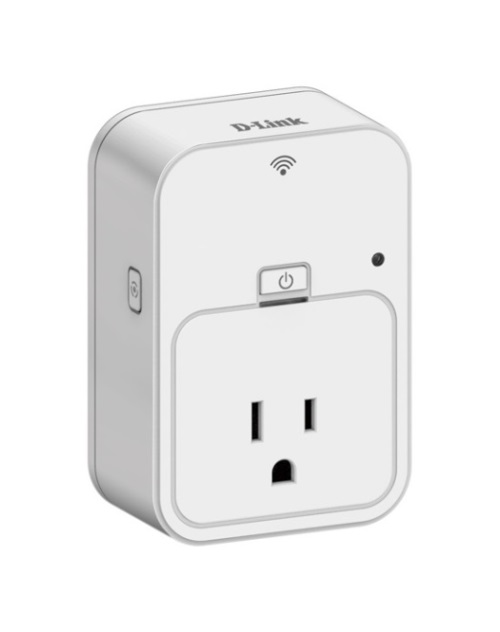D-Link Enters Home Automation Market with Wi-Fi Smart Plug
by Ganesh T S on May 6, 2014 10:01 AM EST- Posted in
- Home Automation
- D-Link
- Wi-Fi

In our coverage of CES 2014, we had pointed out leaks about D-Link's entry into the home automation market with a 'smart' plug controlled via Wi-Fi. Today, D-Link is making the information official.
The D-Link Wi-Fi Smart Plug (DSP-W215) will be the first entry in a series of home automation solutions from the company. Amongst the touted features are power scheduling, local and remote control, monitoring of energy usage and overheating protection (with a thermal sensor) through automatic shutoff. Control and monitoring is made possible through the free mydlink Smart Plug mobile app.
Thanks to the FCC filings, we already have data on the internal platform. Unlike Belkin's WeMo Insight which seems to use a Ralink chipset, the DSP-W215 seems to go the Qualcomm-Atheros route with the Hornet WiSoC platform in the AR1311-AL1A, a member of the same family that is used in the Ubiquit mFi mPower units.
The WeMo Insight and the D-Link Wi-Fi Smart Plug seem to share almost the same feature set, so it would be interesting to see what the differences are in practice - for both the general consumers and the developers / power users.
In particular, it remains to be seen if the APIs to monitor and control the unit are open and whether the unit can be controlled via a web browser and/or PC application. The unit is available today with an EDLP (every-day low price) of $50, which undercuts the MSRP of Belkin's WeMo Insight Switch by $10.
Source: D-Link




















12 Comments
View All Comments
jonsmirl - Tuesday, May 6, 2014 - link
What chip is the QFN package on the power supply board?extide - Wednesday, May 7, 2014 - link
That is the chip that actually measures the power being used by whatever you plug into this thing.willis936 - Tuesday, May 6, 2014 - link
I feel like a control system of this sort would be much more elegant by using the same idea as power line adapters with a diagnostic and control protocol rather than WiFi.Fallen Kell - Tuesday, May 6, 2014 - link
Except that many people do not have power line network capability configured, and in some cases (like apartments and condos) might not even be able to even use it. Wi-Fi on the other hand is pretty much universally used in homes that have home networking configured so things like laptops, tablets, smart-phones, and game consoles can connect.willis936 - Tuesday, May 6, 2014 - link
I think the big thing is that WiFi is cheaper to implement than power line adapters right now. Having a smart plug protocol talk over power cables doesn't mean you already have a power line network already in place. I don't see why apartments couldn't use it either.Fallen Kell - Wednesday, May 7, 2014 - link
Many apartment buildings share power infrastructure which means crosstalk between all apartments within the building, essentially opening up your network to anyone in the building.SuperSpy00bob - Wednesday, May 7, 2014 - link
I can't seem to find anywhere it's amperage rating. They imply you can use high-power appliances with it, but nowhere in the spec sheets does it give any rating besides 125V.Fallen Kell - Wednesday, May 7, 2014 - link
Yeah, it would be nice to know the amperage...will2 - Wednesday, May 7, 2014 - link
About 9 years ago I bought a cheap mains adapter for £9 from a high street store that displayed, Volts, Amps, Power-Factor, True-Watts on its LCD display. It had enough resolution to monitor appliances sipping little power, eg laptop on standby. Since then I have been looking for a similarly priced version that can store that same data in a small buffer memory, for readout over Bluetooth to a Smartphone or laptop, without success.. I suspect the reason D-Link are charging almost 4 times the price is partly due to use of WiFi, whereas Bluetooth is a far cheaper, and more appropriate network for a 'IoT' node. With absolutely zero spec as to its Power Monitoring capability, my guess is, along with some other recent launches, it only measures current, merely 'assuming' a fixed voltage in calculating power; without measuring actual voltage, and most importantly, 'Power Factor', the 'power' figure will be near worthless, i.e. not a SmartPlug ! It is also not encouraging to see its spec sheet states it consumes upto 5W - which is more than the idle power of my Haswell ULV miniPC !Use of BT LE can help cure that, and its high price.
Murloc - Wednesday, May 7, 2014 - link
I still don't see the point. I'd still rather enter the room and click the button than to have to whip out my phone and open the app or browser just to turn on the light.